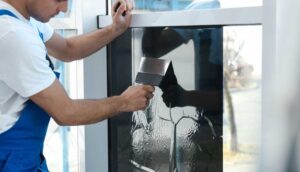
Greenhouse
Every beginner trying out their hand at greenhouse gardening always has to face an important decision- what covering to use for their structure. And this is so important because this choice not only impacts your plants’ growth but also your greenhouse’s efficiency and durability.
It’d be a shame to do everything right but mess with the covering. That one wrong decision could unravel your efforts and leave you weeping.
So we’re going to explore the main types of greenhouse coverings in this article, as well as their pros and cons, and who might benefit most from each option.
Plastic Films
Plastic film, also known as Polyethylene film, is a popular choice for first-time greenhouse owners. They come in various thicknesses; single layer films are the most basic, while double layer films provide more insulation.
Clear films allow more sunlight to pass through into the greenhouse, while diffused films scatter light evenly so much that dark shadows are reduced.
Plastic films are worth considering if you’re working with a limited budget or testing the waters of greenhouse gardening.
Advantages of Plastic Films:
- Budget-friendly for small-scale growers
- Good light diffusion for plant growth
- Easy installation, even for DIY
Disadvantages of Plastic Films:
- Short lifespan (usually 2-3 years)
- Vulnerable to tearing in harsh weather
- Less insulation compared to other options
- Requires regular maintenance
If you experience a mild climate as a beginner, then you should definitely go for a polyethylene covering for greenhouse. It’ll support a wide variety of plants, from vegetables to flowers.
Polycarbonate
Compared to plastic films, polycarbonate offer more durability and insulation. This incredibly strong yet lightweight material is about ⅙ the weight of glass and ⅓ the weight of acrylic. But like plastic films, it also comes in various thicknesses and configurations so they are adaptable to different needs and budgets.
Advantages of Polycarbonate:
- More durable than plastic film (can last up to 10 years)
- Excellent insulation, especially double-layered options
- Resistant to impacts like hailstorms and strong winds
Disadvantages of Polycarbonate:
- Higher upfront cost than plastic film
- Can become cloudy over time which could affect light transmission
- Algae growth is possible in multi-layered panels
If you’ve got variable climates and plan to grow all year round, you’ll like Polycarbonate.
Glass
Glass has been used in greenhouses for centuries, and for good reason. It is a durable and aesthetically pleasing option to cover your greenhouse with.
Advantages of Glass:
- Highest sunlight penetration because of its high light transmission properties
- Aesthetically pleasing
- Will last for a long time if cared for properly.
Disadvantages of Glass:
- Significantly more expensive than other options
- It’s heavy, so there has to be a supporting structure (solid wood or heavy aluminum)
- Glass can shatter when exposed to extreme weather or upon direct contact
Hobbyists and commercial growers often use glass. In other words, if aesthetics and light quality is your priority, go with glass.
Acrylic
Acrylic, also known as Plexiglass or polymethyl methacrylate (PMMA) is increasingly popular amongst greenhouse beginners looking for a transparent, durable covering.
This material offers many of the benefits of glass.
Advantages of Acrylic:
- Excellent light transmission, similar to glass
- Significantly lighter than glass which makes installation easier
- More impact-resistant than glass
- Good insulation properties
- Can withstand weather conditions and UV exposure remarkably
Disadvantages of Acrylic:
- More expensive than polycarbonate or fiberglass
- Can scratch more easily than glass
- May become brittle and crack over time when exposed to UV rays
- Expands and contracts more than glass so it needs to be installed carefully
Acrylic is an excellent choice for gardeners who want the clarity of glass but aren’t comfortable with its weight or risk of breakage.
Fiberglass
Last but not least, we have fibreglass. Think of it as a love child of plastic and glass; offering the durability of rigid panels and the lightness of plastics.
Advantages of Fibreglass:
- Lightweight yet durable
- Distributes light uniformly across the greenhouse, thereby minimizing shadows and promoting healthy plant growth
- Can withstand diverse weather conditions
- Lifespan of about 15-20 years
Disadvantages of Fibreglass:
- May turn yellow or become brittle over time
- You might find it difficult to clean because of its textured surface
- Not as clear as glass, which may affect viewing pleasure
- More expensive than plastic sheeting
- Provides less impact resistance compared to glass
If you live in an area plagued with adverse weather conditions, get yourself fibreglass.
Conclusion
You should know that there’s no one-size-fits-all when it comes to greenhouse coverings. Your decision needs to factor in your unique combination of needs, environment/climate, and gardening goals. Consider the pros and cons of each option first.







